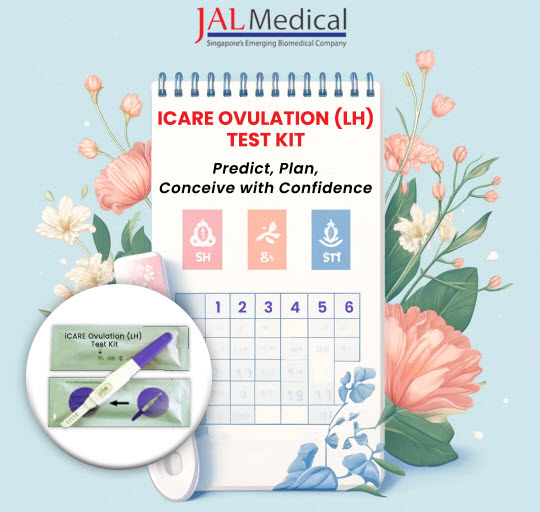1. Overview of Luteinizing Hormone (LH)
Luteinizing Hormone (LH) is a glycoprotein hormone secreted by the anterior pituitary gland. In females, LH plays a crucial role in the menstrual cycle by triggering ovulation and stimulating the production of progesterone by the corpus luteum. In males, LH stimulates the Leydig cells in the testes to produce testosterone.
Understanding LH is essential in reproductive health as it indicates the timing of ovulation in females and can help diagnose conditions such as infertility or hormone imbalances. Monitoring LH levels is particularly important for fertility assessments and managing conditions like polycystic ovary syndrome (PCOS) or hypogonadism in men.
2. Technology Behind LH Rapid Test Kits
Luteinizing Hormone rapid test kits utilize an immunochromatographic assay principle. The test device typically consists of a sample pad, conjugate pad, nitrocellulose membrane with immobilized antibodies, and an absorbent pad. Here’s how it works:
- Sample application: A sample (urine or serum) is applied to the sample pad, where LH in the sample binds to gold-labeled antibodies.
- Migration: The sample moves through the nitrocellulose membrane via capillary action.
- Detection zone: If LH is present in the sample, it binds to immobilized antibodies in the detection zone, producing a visible line.
- Control zone: A control line confirms proper test functioning and sample migration.
The interaction between LH and antibodies on the test strip generates a visible result within minutes, indicating the presence or absence of LH in the sample.
3. Applications of LH Rapid Test Kits
LH rapid test kits have several clinical applications:
- Predicting ovulation: LH surge detection helps women time intercourse for conception or assists in fertility treatments like intrauterine insemination (IUI) or in vitro fertilization (IVF).
- Monitoring fertility treatments: LH levels are monitored during ovulation induction therapies (e.g., with clomiphene citrate or gonadotropins) to assess treatment response and adjust medication dosages.
- Diagnostic tool: LH testing aids in diagnosing hormone disorders such as PCOS (characterized by elevated LH levels) or hypogonadism in men (characterized by low LH levels).
The rapid results provided by LH test kits facilitate timely decision-making in fertility management and hormone disorder diagnosis.
4. Benefits of LH Rapid Test Kits
- Rapid results: LH rapid tests provide results within minutes, allowing immediate interpretation and action.
- Convenience: They are user-friendly and suitable for point-of-care testing in various settings, including clinics, doctor’s offices, and at-home use.
- Cost-effectiveness: Compared to laboratory-based tests like ELISA, LH rapid tests are generally more affordable, reducing healthcare costs associated with fertility monitoring and hormone disorder diagnosis.
These benefits make LH rapid test kits accessible and practical tools in reproductive health management.
5. Clinical Utility and Interpretation of Results
Interpreting LH rapid test results involves understanding the significance of different LH levels:
- Surge detection: A significant rise in LH indicates impending ovulation, guiding optimal timing for conception or fertility treatments.
- Hormone disorders: Elevated or suppressed LH levels can indicate conditions like PCOS or hypogonadism, respectively, prompting further evaluation and treatment.
Healthcare providers integrate LH rapid test results into clinical practice to personalize fertility treatments and manage hormone disorders effectively.

6. Comparison with Traditional LH Testing Methods
Comparing LH rapid tests with traditional methods such as laboratory-based assays (e.g., ELISA) involves considerations of:
- Accuracy and sensitivity: Rapid tests may have slightly lower sensitivity compared to laboratory assays but provide sufficient accuracy for clinical decision-making in most cases.
- Turnaround time: Rapid tests offer immediate results, whereas laboratory tests require sample processing and analysis, leading to longer turnaround times.
- Cost and accessibility: Rapid tests are more cost-effective and accessible, particularly in settings where infrastructure for laboratory testing is limited.
Understanding these differences helps healthcare providers choose the most appropriate testing method based on clinical needs and resource availability.
7. Future Developments and Innovations
Future directions for LH rapid test kits include:
- Enhanced sensitivity: Research focuses on improving test sensitivity to detect lower levels of LH accurately, especially in early-stage ovulation prediction or hormone disorder diagnosis.
- Integration with digital health platforms: Innovations aim to integrate rapid test results with smartphone apps or cloud-based platforms for real-time data sharing and analysis, enhancing patient monitoring and management.
These advancements promise to further optimize the utility and effectiveness of LH rapid test kits in reproductive health care.
8. Considerations and Limitations
Considerations when using LH rapid test kits include:
- Sample collection timing: Timing of sample collection relative to expected LH surge or hormonal fluctuations can affect test accuracy.
- Quality control: Ensuring consistent performance across different batches and manufacturers is essential for reliable test results.
- Interpretation guidelines: Proper training and adherence to interpretive guidelines are necessary to avoid misinterpretation of results and ensure clinical validity.
Addressing these considerations helps maximize the reliability and utility of LH rapid test kits in clinical practice.
Conclusion
LH rapid test kits are valuable tools in reproductive health management, offering rapid, cost-effective, and accessible measurements of LH levels critical for fertility monitoring and hormone disorder diagnosis. As technology continues to advance, these kits are poised to play an increasingly integral role in improving patient outcomes and advancing reproductive healthcare globally.

